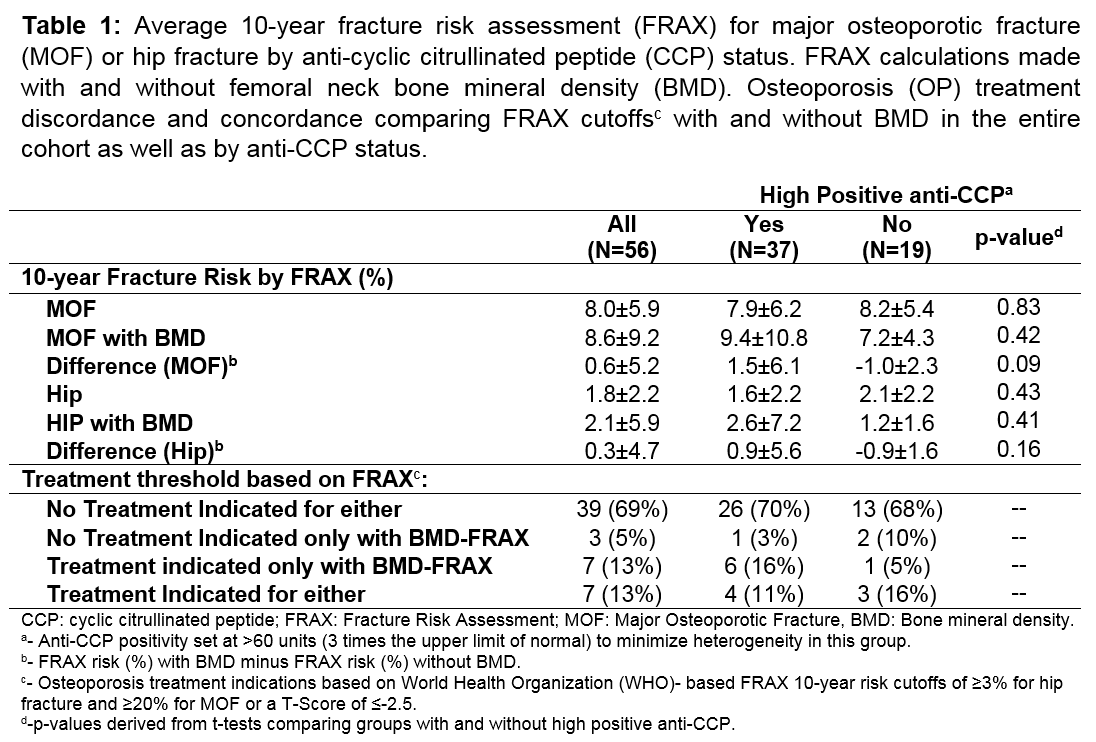Session Information
Date: Tuesday, November 12, 2019
Title: Osteoporosis & Metabolic Bone Disease – Basic & Clinical Science Poster
Session Type: Poster Session (Tuesday)
Session Time: 9:00AM-11:00AM
Background/Purpose: FRAX (Fracture Risk Assessment Tool) is the most commonly used tool to estimate 10-year fracture risk. FRAX estimates are performed with and without bone mineral density (BMD) measures; the BMD-adjusted FRAX (BMD-FRAX) provides a more sensitive estimate. In the United States, if FRAX major osteoporotic fracture (MOF) risk is ≥20% or the hip fracture risk is ≥3% or the T-score is ≤-2.5, then osteoporosis (OP) treatment is recommended. Rheumatoid arthritis (RA) is a risk factor for fracture in FRAX; however, RA is a heterogenous disease so it is important to identify which disease characteristics influence fracture risk. Anti-cyclic citrullinated peptide (CCP) positivity is thought to be a risk factor for lower BMD in RA. Our aim was to evaluate the difference in FRAX and BMD-FRAX estimates and OP treatment categories based on anti-CCP status.
Methods: Data were from the University of California San Francisco RA Cohort. All participants who had complete FRAX variable data and a DXA with a femoral neck BMD measure were included. Because OP medications improve BMD, thereby altering the risk of fracture, only OP medication naïve patients were included in the analysis. Participants were stratified by high positive anti-CCP status (dichotomized at >60 units to minimize heterogeneity of this group). Differences between FRAX and BMD-FRAX risk estimates were calculated for MOF and hip fracture. FRAX and BMD-FRAX based OP treatment categories were also compared.
Results: 56 OP medication naïve RA patients were included in this analysis. Subjects were 61.5±8.5years of age, 79% (n=44) were female and the majority were Hispanic (48%, n=27) or Asian (23%, n=13). Average disease duration was 11.9±8.9 years and mean Disease Activity Score 28 Joints with Erythrocyte Sedimentation Rate (DAS28ESR) was 3.9±1.2. The average prednisone dose was 3.3±4.5 mg/day. 66% (n=37) were categorized as high positive anti-CCP. No significant differences in RA disease characteristics were noted based on anti-CCP status. Individuals with high positive anti-CCP had a greater estimated fracture risk (MOF: +1.5±6.1%, Hip: +0.9±5.6%; See table) when FRAX was adjusted with BMD. Conversely, the group with lower anti-CCP values had decreased estimated fracture risk when BMD was added to FRAX (MOF: -1.0±2.3%, Hip: -0.9±1.6%), although these differences did not reach statistical significance. Changes in treatment category based on BMD-FRAX was supported in 18% (n=10) individuals; escalation of therapy was supported in 16% (n=6) of high positive anti-CCP individuals compared to 5% (n=1) in those with lower anti-CCP levels.
Conclusion: Adding BMD adjustment to FRAX scores increases the risk estimate in persons with high-positive anti-CCP levels but decreases the risk estimate in others. BMD-adjusted FRAX supports changes in OP treatment recommendations in nearly 1/5 of RA patients. Our data suggest that high positive anti-CCP individuals may represent a subset of the RA population who have an elevated risk for fracture that is not accurately captured in FRAX scores without BMD adjustment. Further studies in larger populations of OP medication naïve RA patients are needed to confirm these findings.
To cite this abstract in AMA style:
Wysham K, Graf J, Margaretten M, Trupin L, Andrews J, Shoback D, Katz P. Differences in Fracture Risk Assessment (FRAX) and Osteoporosis Treatment Cutoffs with and Without Bone Mineral Density Are Greater in Anti-Cyclic Citrullinated Peptide Positive Rheumatoid Arthritis [abstract]. Arthritis Rheumatol. 2019; 71 (suppl 10). https://acrabstracts.org/abstract/differences-in-fracture-risk-assessment-frax-and-osteoporosis-treatment-cutoffs-with-and-without-bone-mineral-density-are-greater-in-anti-cyclic-citrullinated-peptide-positive-rheumatoid-arthritis/. Accessed .« Back to 2019 ACR/ARP Annual Meeting
ACR Meeting Abstracts - https://acrabstracts.org/abstract/differences-in-fracture-risk-assessment-frax-and-osteoporosis-treatment-cutoffs-with-and-without-bone-mineral-density-are-greater-in-anti-cyclic-citrullinated-peptide-positive-rheumatoid-arthritis/

